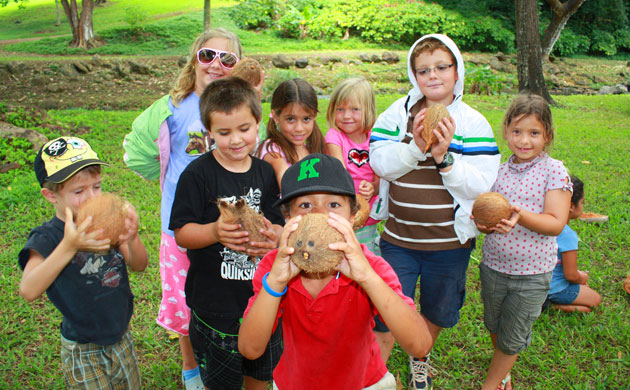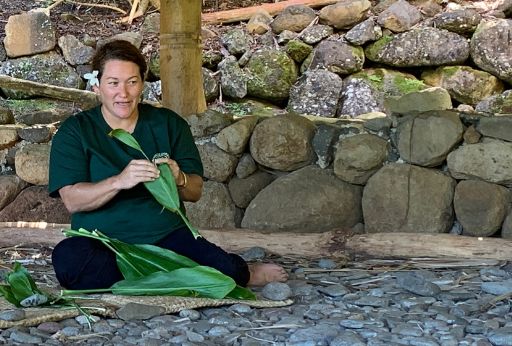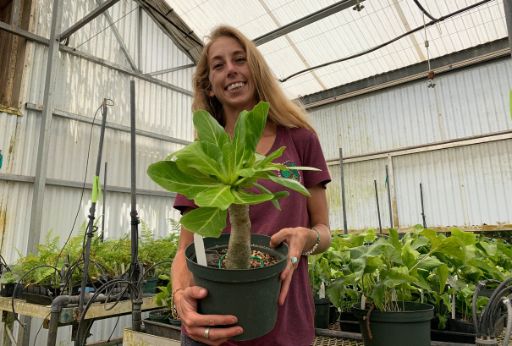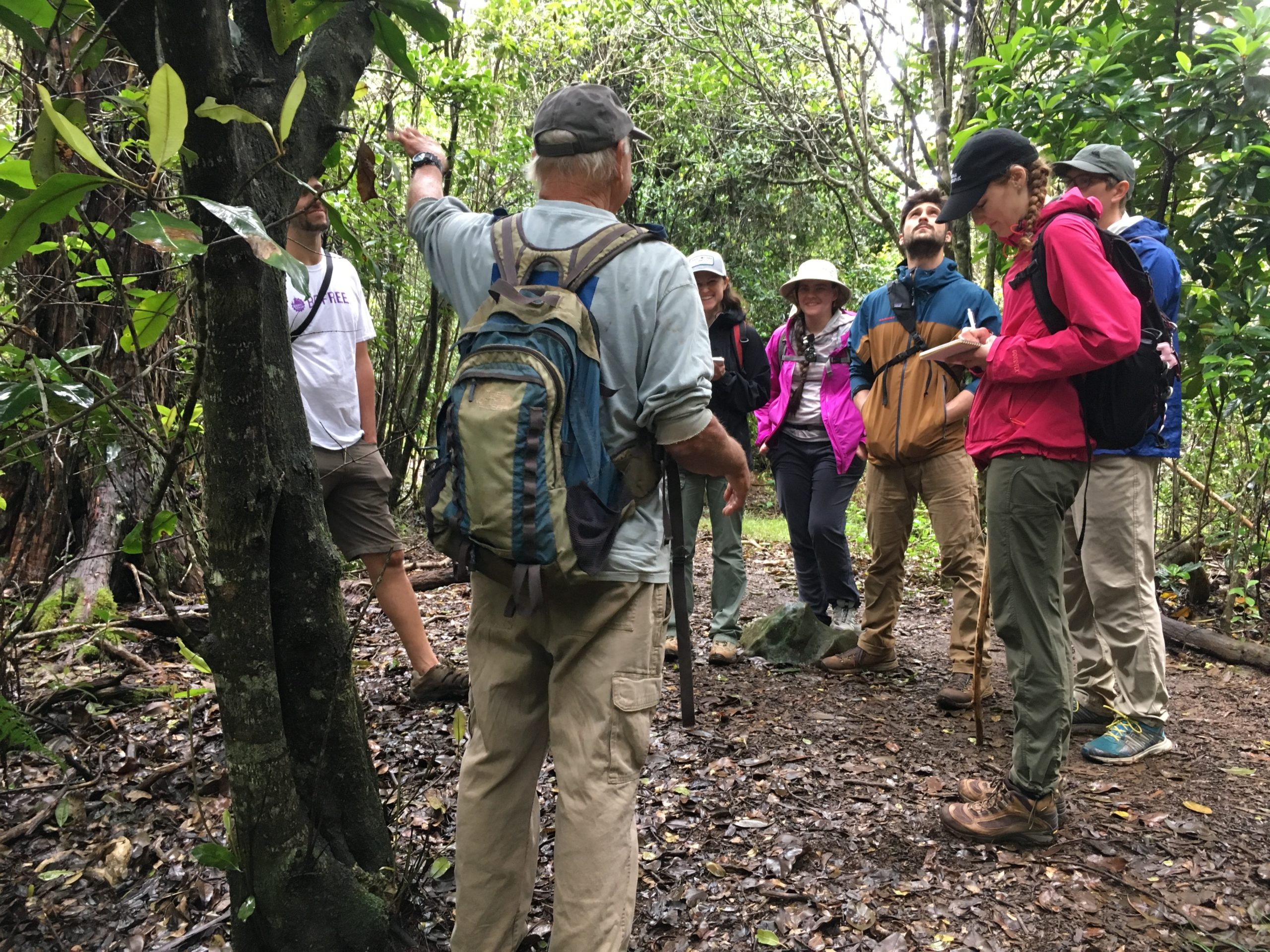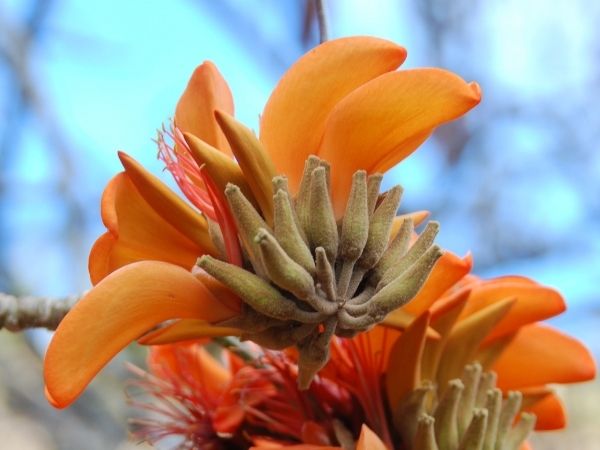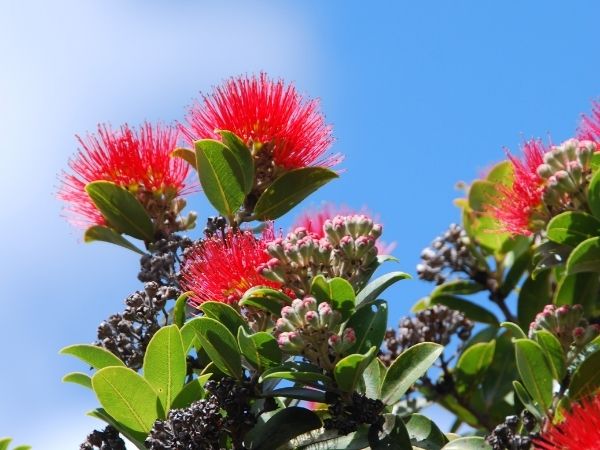Tropical Plant Database - Plant Details
Pandanus tectorius
Click on any heading above to view more information about this plant
Conservation Status
- IUCN: least concern
- USFWS: None
Steve Perlman speaking about Pandanus tectorius
Family: PANDANACEAE
Genus: Pandanus
Species: tectorius
Species Author: Parkinson
Vernacular: Hala, pu hala, lauhala, screw pine
Synonyms: Pandanus odoratissimus, Pandanus temehaniensis
Genus: Pandanus
Species: tectorius
Species Author: Parkinson
Vernacular: Hala, pu hala, lauhala, screw pine
Synonyms: Pandanus odoratissimus, Pandanus temehaniensis
Pandanus tectorius is a small tree growing to 10 meters in height with a canopy spreading 5 to 12 m in diameter. The trunk is multi-branched and often has aerial roots that decend from the upper canopy to the ground (prop roots). The light green leaves are spirally arranged at the ends of the branches and have long linear blades about 4 to 8 cm wide and 80 to 180 cm long. Most varieties have spines along the edges and on the midribs of the leaves. Spineless and variegated forms are available. Pandanus tectorius trees are either male or female. Female trees produce a large, segmented fruit somewhat resembling a pineapple. Male trees produce large clusters of tiny, fragrant flowers surrounded by white to cream colored bracts. These clusters are about 30 cm long and are called hinano in Hawaiian.
The fruit is a large, woody, subglobose syncarp with numerous (often 50 or more) woody keys containing a buoyant mesocarp with one or more seeds.
(Wagner, Warren L., Darrel R. Herbst, and S. H. Sohmer. 1990. Manual of the flowering plants of Hawai'i; Lamb. 1981; Meilleur et al. 1997; NTBG. 1996; Hensley. 1997)
(Whistler, W.A. 1992. Polynesian Herbal Medicine)
The fruit is a large, woody, subglobose syncarp with numerous (often 50 or more) woody keys containing a buoyant mesocarp with one or more seeds.
(Wagner, Warren L., Darrel R. Herbst, and S. H. Sohmer. 1990. Manual of the flowering plants of Hawai'i; Lamb. 1981; Meilleur et al. 1997; NTBG. 1996; Hensley. 1997)
(Whistler, W.A. 1992. Polynesian Herbal Medicine)
In Hawai'i, the juice from the aerial roots tips (ule hala) was used as a tonic and to treat scrofula (a tuberculous infection of the skin of the neck, most often caused by mycobacteria (Mycobacterium tuberculosis)in adults; in children, it is usually caused by Mycobacterium scrofulaceum and Mycobacterium avium. The male flowers and the juice from crushed roots added to coconut oil were used as a laxative.
In Tahiti, the juice from the aerial root tips was employed in treating skin inflammation.
In Tonga, juice from the root tips, mixed with tumeric(Curcuma longa) and grated coconut, is applied to sores.
In the Cook Islands, juice from the crushed roots, fried with coconut cream, is a commonly used laxative. Skin from the ripe fruit is used for urinary tract problems.
Whistler,W.A. 1992. Polynesian Herbal Medicine)
In the Philippines, a decoction of fresh or dried prop root is used as a diuretic. For headache, arthritis, and stomach spasms a decoction of leaves is used. A poultice of fresh leaves mixed with oil is also used for headaches, and pulverized dried leaves was used to facilitate wound healing. A decoction of roots is believed to have aphrodisiac and cardiotonic properties.
In Fiji, a tea made from the leaves is drunk freely as a remedy for diarrhea. A drink made from the aerial roots is given for 4 days to treat an illness known as "crazy child", in which the eyes wander. Asthma and back pains are also treated with the filtrate of the aerial roots. Liquid squeezed from the above-ground aerial roots and the inner bark is employed in the treatment of heart attack. In Namosi, the juice from the root and bark is used to treat internal fractures. A mixture made from the pandanus roots, the barks of Wi (Spondias dulcis), Kavika (Syzygium malaccense) and the milk of the young Niu (red coconut, Cocos nucifera) is used to treat poisoning from eating the red parrot fish (Damu). (Cambie,R.C. and Ash,J. 1994. Fijian Medicinal Plants.)
In Tahiti, the juice from the aerial root tips was employed in treating skin inflammation.
In Tonga, juice from the root tips, mixed with tumeric(Curcuma longa) and grated coconut, is applied to sores.
In the Cook Islands, juice from the crushed roots, fried with coconut cream, is a commonly used laxative. Skin from the ripe fruit is used for urinary tract problems.
Whistler,W.A. 1992. Polynesian Herbal Medicine)
In the Philippines, a decoction of fresh or dried prop root is used as a diuretic. For headache, arthritis, and stomach spasms a decoction of leaves is used. A poultice of fresh leaves mixed with oil is also used for headaches, and pulverized dried leaves was used to facilitate wound healing. A decoction of roots is believed to have aphrodisiac and cardiotonic properties.
In Fiji, a tea made from the leaves is drunk freely as a remedy for diarrhea. A drink made from the aerial roots is given for 4 days to treat an illness known as "crazy child", in which the eyes wander. Asthma and back pains are also treated with the filtrate of the aerial roots. Liquid squeezed from the above-ground aerial roots and the inner bark is employed in the treatment of heart attack. In Namosi, the juice from the root and bark is used to treat internal fractures. A mixture made from the pandanus roots, the barks of Wi (Spondias dulcis), Kavika (Syzygium malaccense) and the milk of the young Niu (red coconut, Cocos nucifera) is used to treat poisoning from eating the red parrot fish (Damu). (Cambie,R.C. and Ash,J. 1994. Fijian Medicinal Plants.)
Pandanus tectorius is one of the most useful trees to Pacific Islanders. The leaves, which are the most useful part of the plant, are woven or plaited into mats, thatch, sails, baskets, hats, local fans, etc. On islands where it it too dry to cultivate breadfruit and most root crops, pandanus fruit serves as an important source of carbohydrate. (Whistler,W.A. 1992. Polynesian Herbal Medicine)
In Samoa, the fragrant flowers are used for lei, which are worn only by chiefs.(Tavana, N.G. 2003. NTBG)
In Samoa, the fragrant flowers are used for lei, which are worn only by chiefs.(Tavana, N.G. 2003. NTBG)
Pandanus tectorius native to the tropical Pacific shores of Polynesia, Micronesia, Melanesia and Australia. A similar species, P. odoratissimus, is found futher westward in Malaysia and India. In Hawaii, hala is found on all the main islands except Kaho'olawe. Pandanus tectorius grows in moist coastal locations and valley slopes to an elevation of 600 m. Although ancient lava casts of the fruit on Kauai have shown that hala native to Hawaii, Polynesian varieties may have been introduced by early Hawaiian colonizers.
(Wagner, Warren L., Darrel R. Herbst, and S. H. Sohmer. 1990. Manual of the flowering plants of Hawai'i)
(Wagner, Warren L., Darrel R. Herbst, and S. H. Sohmer. 1990. Manual of the flowering plants of Hawai'i)
The fruit is a major source of food in Micronesia especially on the atolls. The fleshy, juicy keys can be eaten raw or cooked. Either way, it is very healthy. Tips of the roots are also eaten.
(Whistler,W.A. 1992. Polynesian Herbal Medicine.)
(Whistler,W.A. 1992. Polynesian Herbal Medicine.)
Regarded as the Nature Spirit (Kupua) in ancient Hawai'i, the picturesque Hala tree has been revered for centuries by Pacific people. According to Hawaiian tradition, this tree contributed to the origin of mankind: a beautiful young godess was once busy cutting Hala leaf strips for mat-weaving, when her shell-trimmer slipped and cut her finger. The finger bled profusely, and as the blood coagulated, two eggs formed. From these eggs emerged the mother and father of the human race.
(Kepler, A. K. 1983. Hawaiian Heritage Plants.)
(Kepler, A. K. 1983. Hawaiian Heritage Plants.)
The volatile oil of the male flowers of Pandanus tectorius has been investigated. Among other compounds it contains methyl B-phenylethyl ether, dipentene, (+)-linalool, phenylethyl acetate, citral, phenylethyl alcohol, and an ester of phthalic acid. The leaves of Pandanus amaryllifolius (reported to be a synonym of P. odoratissimus) containe pandamarine.
(Cambie,R.C.and Ash, J. 1994. Fijian Medicinal Plants)
(Cambie,R.C.and Ash, J. 1994. Fijian Medicinal Plants)
- 084767 - collected by Art Whistler in 1974
- 084768 - collected by Art Whistler in 1974
- 084761 - collected by Art Whistler in 1974
- 084766 - collected by Art Whistler in 1974
- 084763 - collected by Art Whistler in 1974
- 084856 - collected by Art Whistler in 1976
- 084854 - collected by Art Whistler in 1976
- 084757 - collected by Art Whistler in 1976
- 084758 - collected by Art Whistler in 1976
- 084762 - collected by Art Whistler in 1976
- 084759 - collected by Art Whistler in 1976
- 084760 - collected by Art Whistler in 1976
- 084858 - collected by Art Whistler in 1977
- 033531 - collected by Michael J. Balick in 1977
- 084857 - collected by Art Whistler in 1980
- 084855 - collected by Art Whistler in 1980
- 084769 - collected by Art Whistler in 1980
- 061739 - collected by Art Whistler in 1981
- 006891 - collected by Tim Flynn in 1987
- 006890 - collected by Tim Flynn in 1987
- Unassigned - collected by K. R. Wood in 1995
- 021161 - collected by David H. Lorence in 1996
- 026223 - collected by David H. Lorence in 1997
- Unassigned - collected by David H. Lorence in 1998
- 053943 - collected by Art Whistler in 1998
- 034863 - collected by David H. Lorence in 2001
- 034862 - collected by David H. Lorence in 2001
- 053009 - collected by Michael J. Balick in 2002
- 039573 - collected by David H. Lorence in 2003
- 041046 - collected by K. R. Wood in 2003
- 039738 - collected by David H. Lorence in 2003
- 040680 - collected by K. R. Wood in 2003
- 042414 - collected by K. R. Wood in 2004
- S046555 - collected by Tim Flynn in 2005
- 053871 - collected by Forest Starr in 2005
- 054534 - collected by Michael J. Balick in 2006
- Unassigned - collected by K. R. Wood in 2009
- Unassigned - collected by K. R. Wood in 2009
- 057481 - collected by David H. Lorence in 2011
- 024135 - collected by Steve Perlman in 2011
- 023941 - collected by F. R. Fosberg in 2013
- 094595 - collected by David H. Lorence in 2021
- 088075 - collected by David H. Lorence in 2021
- 093253 - collected by David H. Lorence in 2021
- Unassigned - collected by Susan Fawcett in 2024
We currently have 45 herbarium specimens for Pandanus tectorius in our collection. Click on any specimen below to view the herbarium sheet data.
.svg)













